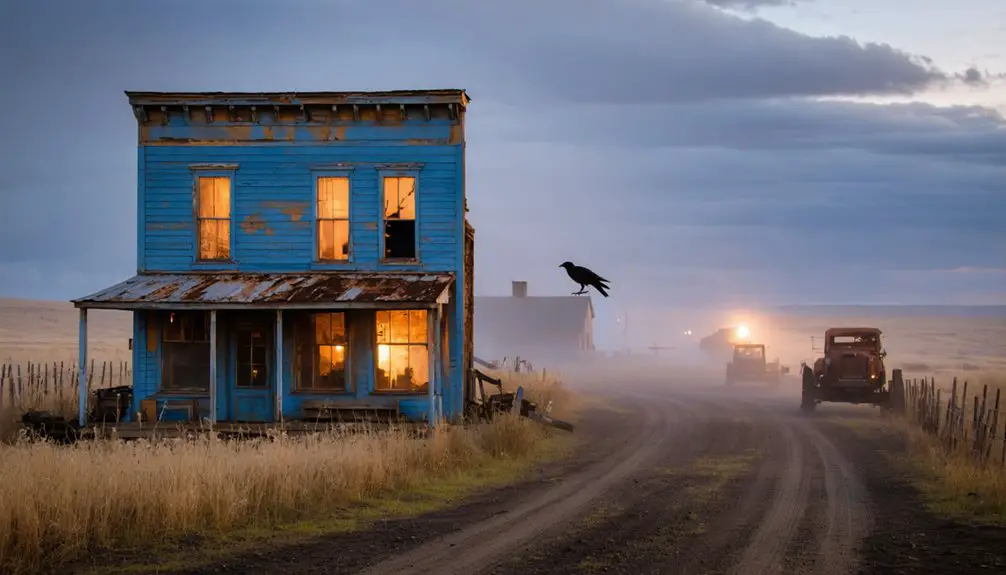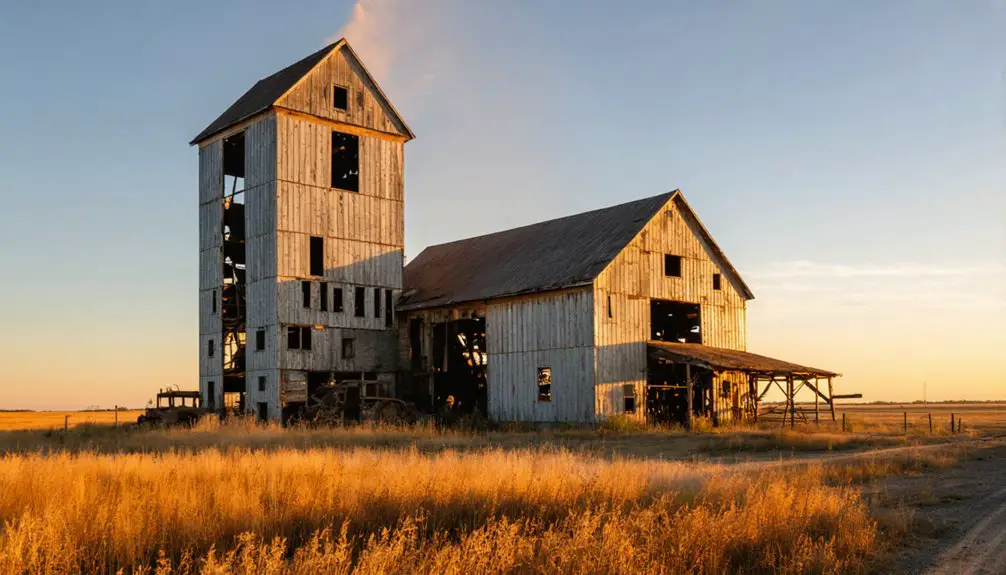You’ll discover the remnants of Splitrock, Minnesota, a ghost town established in 1899 by Split Rock Lumber Company at Lake Superior’s edge. The site operated until 1907, supporting 350 workers with extensive infrastructure including a harbor, railroad, and company store. Today, you can explore the preserved ruins of this once-thriving lumber town, from wharf pilings to building foundations. The area’s rich maritime heritage and local legends add deeper layers to its fascinating industrial past.
Key Takeaways
- Splitrock was established in 1899 by Split Rock Lumber Company as a logging town supporting 350 workers with complete infrastructure.
- The town operated successfully until 1907, when unsustainable logging practices depleted local timber resources and forced closure.
- Physical remnants include wharf pilings, railroad foundations, crushing house ruins, and stone fireplaces from former homes and bunkhouses.
- Workers lived in crowded bunkhouses and relied on the company store, creating a self-contained community during its operational years.
- The site now features interpretive trails allowing visitors to explore preserved ruins and cellar holes from the former logging town.
The Rise of a Company Town
When the Split Rock Lumber Company established Splitrock in 1899, they created a quintessential company town designed to support their extensive logging operations in northern Minnesota.
You’ll find the company dynamics reflected in every aspect of the settlement, from the strategic location at the Split Rock River’s mouth to the thorough infrastructure they built to sustain their logging community.
The company constructed a harbor, railroad, coal dock, and company store with a post office to support approximately 350 workers.
Their self-contained operation included the Split Rock and Northern Railroad, a 10-mile line dedicated solely to timber transport.
The dangerous shipping conditions and numerous shipwrecks along Lake Superior’s shore led Congress to appropriate $75,000 for a lighthouse in 1907.
The town’s development showcased the complete control the company maintained over its workers’ lives, providing all essential services while monopolizing the local economy.
The company’s operations continued until 1906, when logging in the area ceased.
Life in the Lumber Camp
While the Split Rock Lumber Company provided the basic infrastructure for its workers, daily life in Splitrock’s lumber camp proved harsh and demanding for the 350 men who called it home between 1899 and 1906.
You’d find yourself sleeping in crowded bunkhouses on beds made of marsh hay or balsam boughs, enduring unsanitary conditions and minimal comfort. Despite the challenges, worker camaraderie emerged as men bonded over shared ethnic backgrounds and the isolating nature of camp life. When not working, men would walk along the 10-mile railroad line to transport supplies and materials between camps.
Men found brotherhood in the harsh confines of lumber camp bunkhouses, where shared hardship forged lasting bonds across cultures.
You’d face constant logging dangers: felling massive pines with manual tools, battling harsh weather, and risking injury far from proper medical care.
The company store supplied your basic needs, but you’d have little economic freedom in this remote, self-contained community where long work hours left scarce time for leisure.
Economic Success and Swift Decline
The Split Rock Lumber Company’s economic prowess emerged through its efficient exploitation of the region’s dense pine forests. Their logging practices yielded an impressive 200 million board feet of lumber by 1906, generating profits exceeding $863,000. The area later gained significant attention when a devastating 100-foot cliff became the chosen site for the lighthouse construction in 1910.
You’ll find their economic resilience reflected in their extensive control of essential infrastructure, including a private railroad, harbor facilities, and company store. The area later gained prominence when U.S. Steel Corporation advocated for establishing a lighthouse to protect their vessels carrying iron ore through the dangerous waters.
- Employed 350 men at peak operations, demonstrating significant local economic impact
- Built and operated a dedicated 10-mile railroad for efficient timber transport
- Controlled all crucial infrastructure through centralized company ownership
- Utilized advanced communication methods, including carrier pigeons for maritime safety
- Achieved remarkable profits before swift resource depletion led to closure in 1907
Despite this success, the operation’s unsustainable logging practices led to rapid resource depletion, forcing the town’s abandonment and leaving only remnants of its prosperous past visible today.
Nautical Links and Maritime Heritage
The lighthouse’s technological innovations revolutionized maritime safety with its 450,000-candlepower Fresnel lens, visible for 22 miles across the lake.
You can appreciate the engineering marvel of its construction – perched 168 feet above the water on a sheer cliff, with materials hoisted by crane before roads existed.
Despite these advancements in shipwreck prevention, vessels like the Viking and Cygnus still met their fate near these rocky shores. Built in response to the devastating Mataafa Storm of 1905, the lighthouse aimed to prevent future maritime disasters on Lake Superior. The original French-built lens remains housed in the lantern room, preserving its historic authenticity.
Physical Remnants and Historical Sites
When you visit Splitrock’s ghost town site today, you’ll find substantial physical evidence of its industrial past through the remaining wharf pilings and railroad foundations that once supported the town’s logging operations.
You can trace the footprint of the Split Rock Lumber Company’s activities through concrete remnants of the crushing house near Corundum Point and the visible dam structures at the river mouth.
The foundations of buildings from Little Two Harbors fishing village and industrial structures throughout the park serve as tangible links to the area’s maritime and commercial heritage. The area’s historical significance was further enhanced when the U.S. Lighthouse Service completed construction of the iconic Split Rock Lighthouse in 1910. The lighthouse continues to draw visitors who occasionally report encounters with ghostly lighthouse keepers while touring the grounds.
Visible Harbor Infrastructure Remains
Visible remnants of Splitrock’s harbor infrastructure stand as compelling evidence of the town’s industrial past, particularly at the mouth of the Split Rock River.
Despite decades of economic impact on the region’s development, these preserved structures tell a compelling story of maritime commerce and logging operations. The area’s isolation ended when the North Shore Scenic Highway opened in 1924, connecting the harbor ruins to the wider region.
You’ll find the original wharf’s impressive 184-foot span marked by weathered pilings that once facilitated the transport of timber into Lake Superior.
- Original wharf pilings project from the water, spanning 56 meters in length
- Harbor preservation efforts maintain these historic logging platforms
- Dam infrastructure remains visible at the river’s mouth
- Pilings served as essential log-dumping stations for timber transport
- These authentic artifacts are easily accessible within state park boundaries
Railroad Foundations Still Standing
While most of Splitrock’s railroad infrastructure has vanished, significant foundational remnants still mark the path of the Split Rock and Northern Railroad‘s 10-mile route through the river valley.
You’ll find the most visible evidence of this railroad’s significance at the Split Rock River mouth, where wooden pilings from the original wharf and trestle still protrude from the water.
These surviving timbers once supported a massive 184-foot-long loading platform where workers transferred lumber onto rafts bound for Duluth’s sawmills.
Though the rails and ties have long since disappeared, these enduring pilings serve as silent witnesses to Splitrock’s logging history, when the railroad helped extract nearly 200 million board feet of timber before the operation’s closure in 1907.
Building Ruins and Foundations
The scattered building ruins and foundations throughout Splitrock’s former townsite provide a tangible connection to Minnesota’s logging era.
You’ll discover rectangular foundation layouts marking where homes and bunkhouses once stood, along with industrial remnants near the Split Rock River’s mouth. A distinctive stone fireplace significance emerges atop Day Hill, standing as a solitary sentinel to past gatherings.
- Explore stone and concrete foundations revealing the town’s original residential pattern
- Visit the isolated fireplace ruin on Day Hill, accessible via hiking trails
- Examine former logging operation sites with sawmill and storage shed footprints
- Find scattered artifacts like metal tools and building hardware near foundation sites
- Follow interpretive trails through the state park to view preserved ruins and cellar holes
Local Legends and Ghost Stories

You’ll encounter eerie tales of the lighthouse keeper’s ghost patrolling the catwalk at Split Rock Lighthouse, where he continues his eternal watch over Lake Superior.
The remaining harbor pilings from the old logging town stand as silent witnesses to unexplained phenomena reported by visitors exploring the abandoned industrial site.
Local legends also speak of restless spirits from the *Madeira* shipwreck, whose tragic fate in the 1905 storm led to the lighthouse’s construction and subsequent ghostly encounters.
Lighthouse Keeper’s Eternal Watch
Perched atop the rugged cliffs of Lake Superior, Split Rock Lighthouse harbors tales of dedicated keepers who’ve transcended mortality to maintain their eternal watch over passing vessels.
Lighthouse legends tell of mysterious figures spotted near the tower, particularly during stormy nights when keeper devotion was most vital. You’ll find these accounts deeply rooted in the site’s history, from Orren Young’s pioneering service to Lee Radzak’s 37-year tenure.
- Unexplained footsteps echo through the keeper’s quarters
- Strange lights flicker in the tower despite its 1969 decommissioning
- A solitary figure appears during foggy conditions
- Phantom sounds intensify during violent storms
- Visitors report sensing an unseen guardian presence
These phenomena persist as evidence of the keepers’ unwavering commitment to maritime safety, their spirits forever bound to their noble duty.
Haunted Harbor Pilings Remain
Standing as silent sentinels at Split Rock River’s mouth, weathered harbor pilings mark where the Split Rock Lumber Company‘s bustling wharf once facilitated massive logging operations from 1899 to 1906.
These haunted pilings now serve as more than mere historical markers – they’re said to harbor restless spirits of former lumber workers who once toiled here.
You’ll hear stories of ghostly apparitions materializing in the twilight hours, particularly when mist shrouds the river mouth.
Local legends speak of mysterious sounds echoing across the water: the phantom creaking of timber and splashing of logs.
Along the abandoned railroad path, visitors report encounters with shadowy figures and inexplicable lights.
These eerie tales have transformed the industrial remnants into a focal point of North Shore folklore, drawing both history enthusiasts and paranormal investigators.
Madeira Shipwreck Spirits
- Ghostly apparitions of crew members materialize during stormy weather near the point.
- Phantom creaks and knocks echo from the cliff face.
- Spectral lanterns glow mysteriously on wreck anniversary dates.
- Strange mists rise from the water, taking ship-like forms.
- Unexplained cold spots and watched feelings pervade the area.
- https://en.wikipedia.org/wiki/Splitrock
- https://www.cascadevacationrentals.com/6569/haunted-split-rock-lighthouse/
- https://en.wikipedia.org/wiki/Split_Rock_Lighthouse_State_Park
- https://nmgl.org/a-brief-history-of-the-split-rock-lighthouse-fall-1972/
- https://www.mnhs.org/splitrock/learn/history
- https://northwestprimetime.com/news/2024/sep/02/explore-split-rock-lighthouse-one-of-minnesotas-most-iconic-landmarks/
- https://www.cascadevacationrentals.com/3016/pilings-at-split-rock-river/
- http://files.dnr.state.mn.us/forestry/history/documents/historyofForestry-1969.pdf
- https://www.mnhs.org/forestsfieldsfalls/lumbering/lumbering-slide17
- https://infosuperior.com/blog/2018/11/14/split-rock-north-americas-most-visited-light/
These legends amplify Split Rock’s maritime heritage, drawing curious visitors to its storied shores.
Frequently Asked Questions
What Wildlife Inhabited the Splitrock Area During Its Logging Town Period?
You’d find abundant deer populations alongside black bears, moose, and beavers in the forests, while diverse bird species included herring gulls, loons, peregrine falcons, and carrier pigeons.
How Did Extreme Winter Conditions Affect Daily Operations in Splitrock?
You’d face brutal winter survival challenges as ice choked harbors, snow buried rail lines, and freezing temperatures slowed logging. Daily operational challenges included maintaining warmth, clearing transport routes, and protecting worker health.
What Medical Care Was Available to Workers and Families?
You’d find limited healthcare access, relying mainly on nearby Pokegama Sanatorium for tuberculosis and Anoka State Hospital for mental health. Worker injuries received basic first aid without on-site medical staff.
Did Any Notable Crimes or Incidents Occur During Splitrock’s Existence?
You won’t find any murder mysteries or definitive crime statistics from Splitrock’s brief existence. While harsh working conditions and isolation created potential for conflict, no major criminal incidents were officially documented.
How Did Native American Communities Interact With the Logging Town?
Like ships passing in the night, you’ll find Native American communities had limited cultural exchanges with Splitrock, mainly through occasional labor roles, though they maintained separate trade relationships outside the town’s operations.



